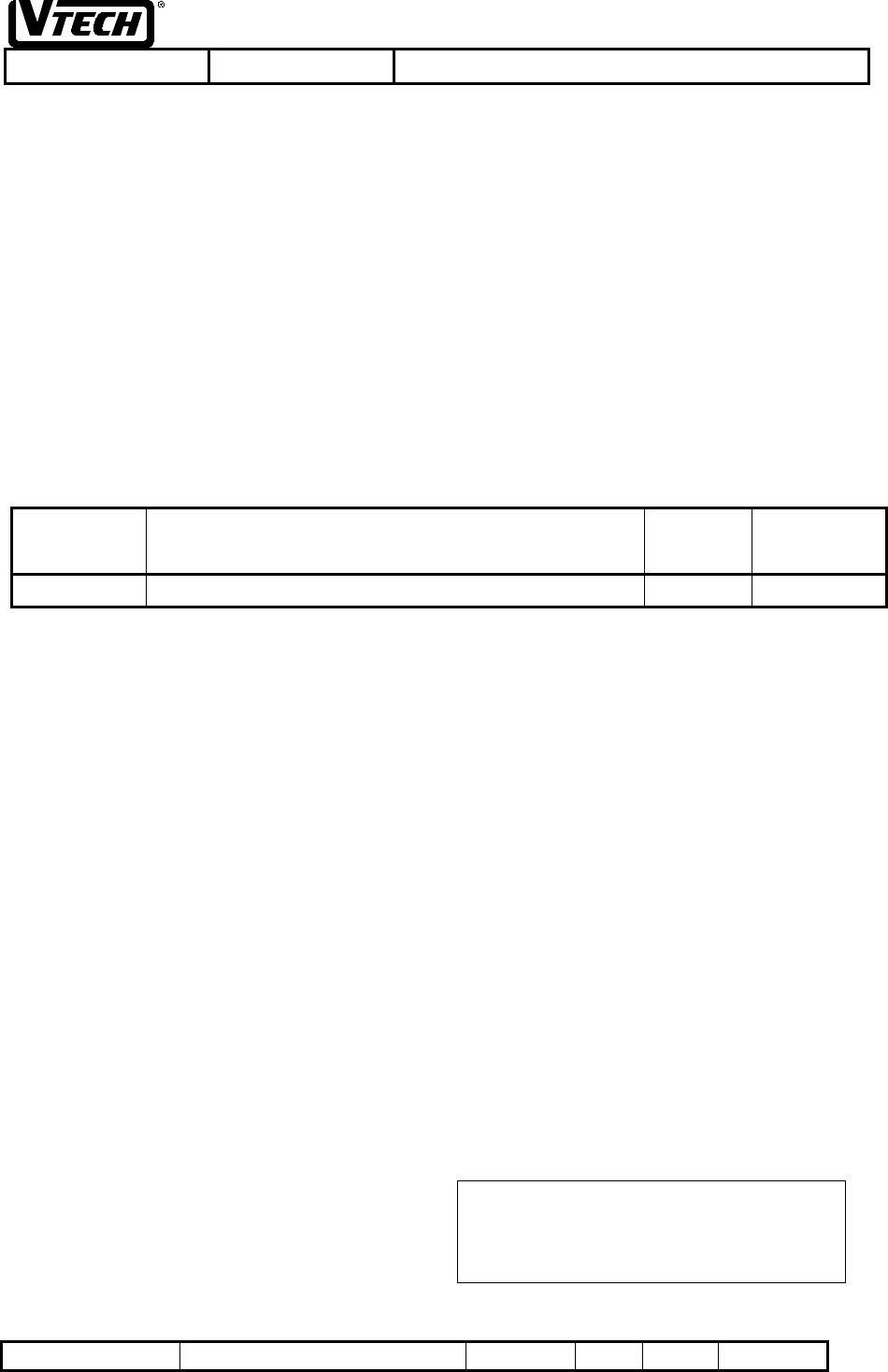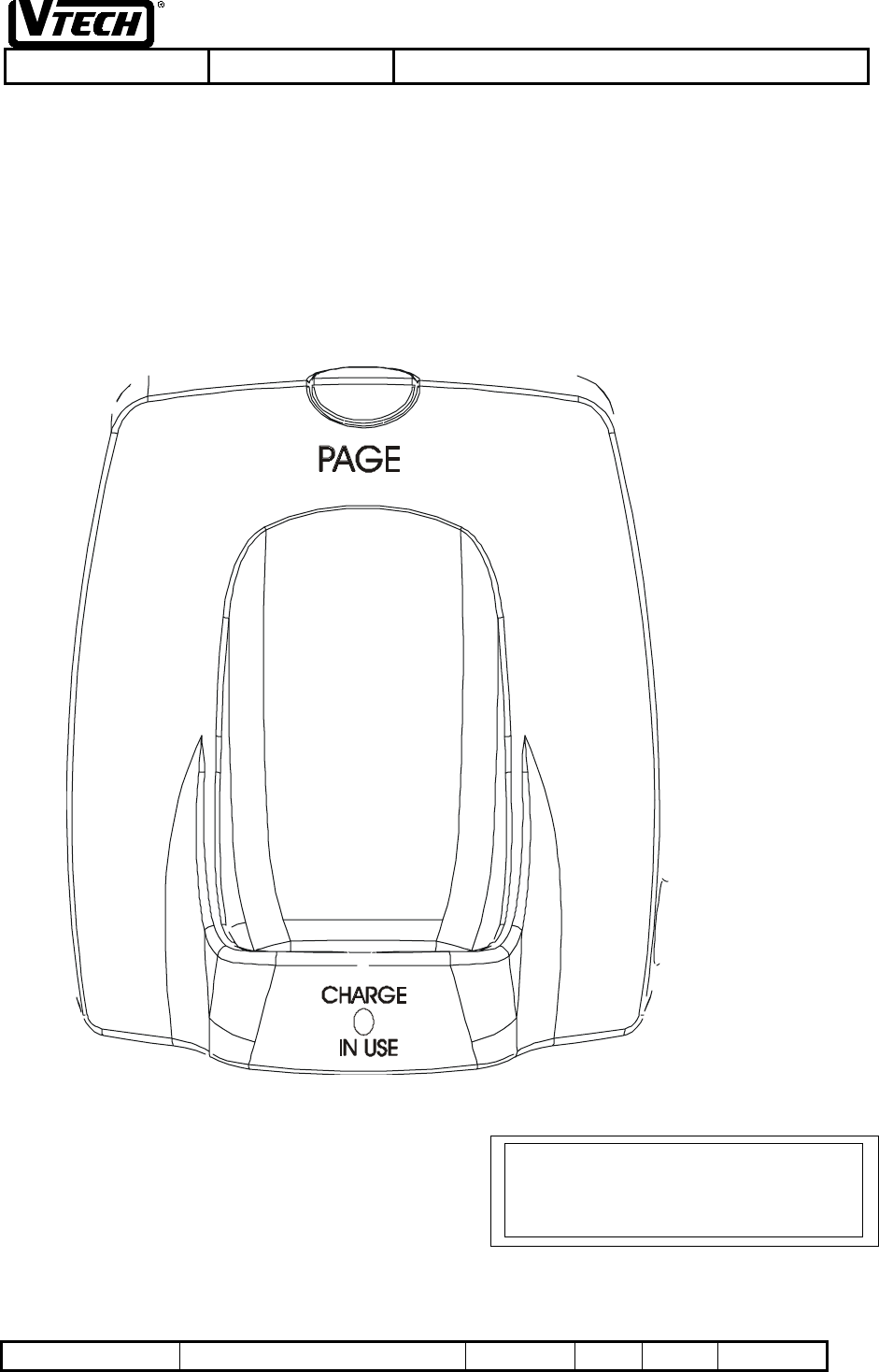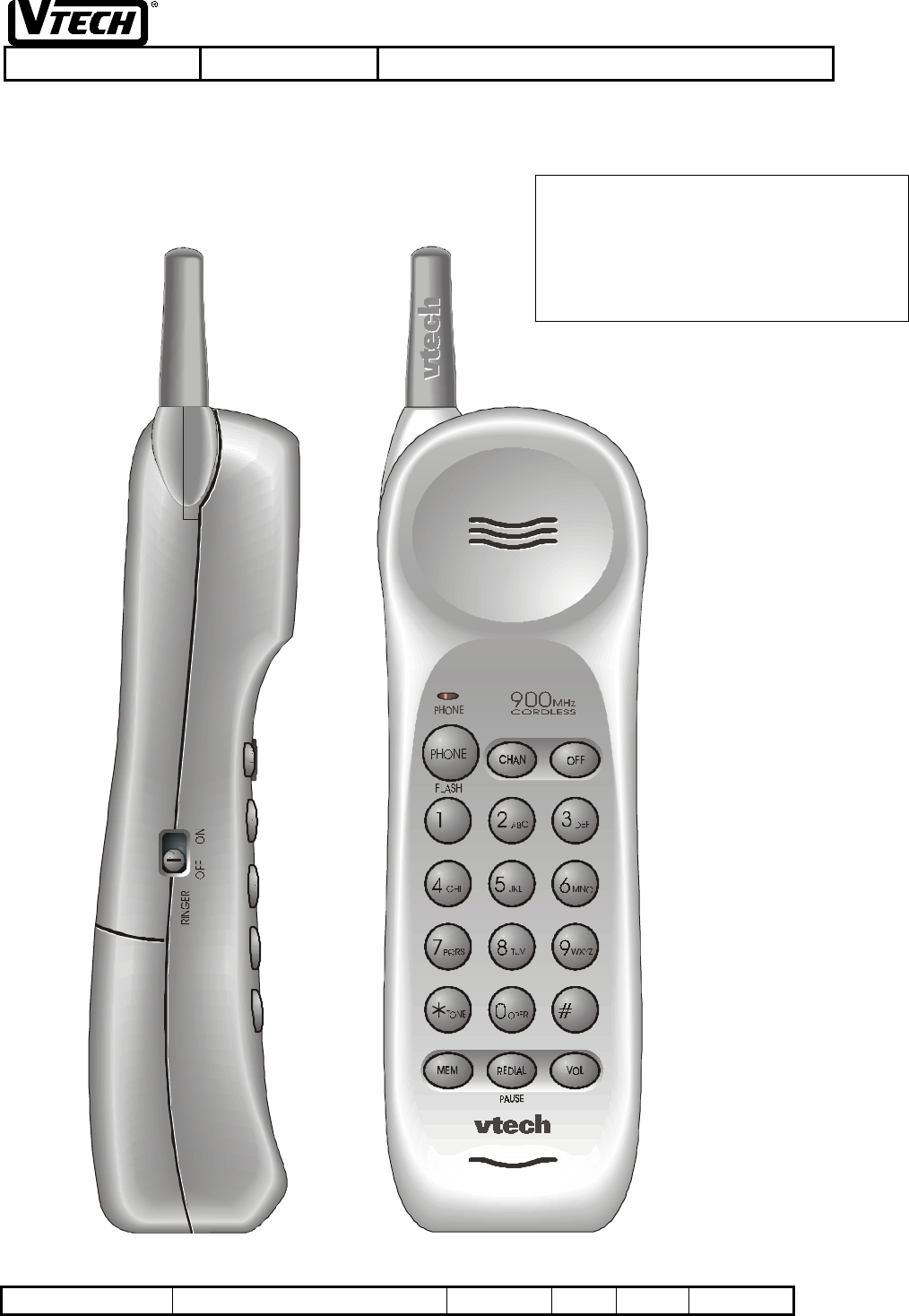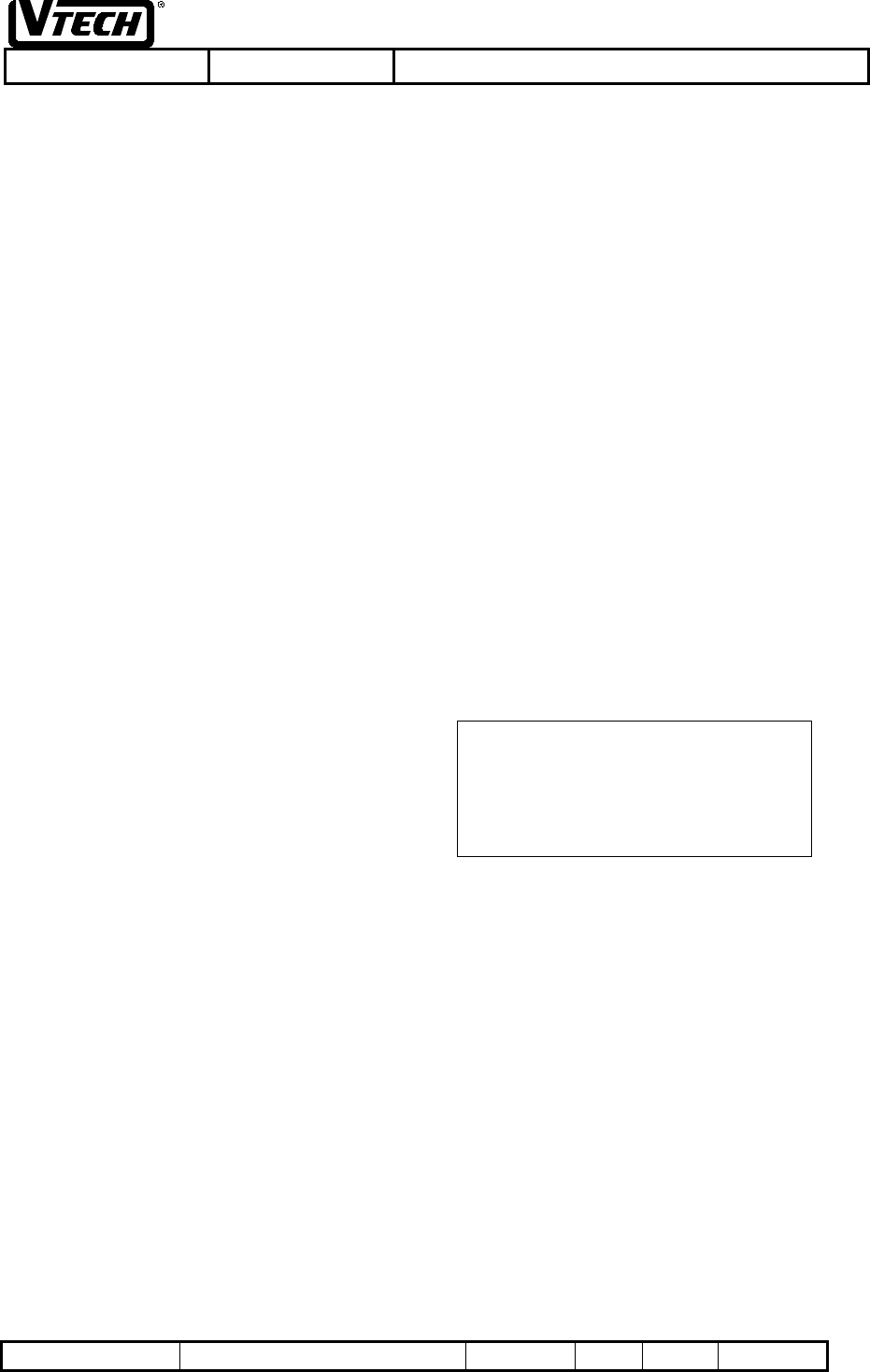VTech Telecommunications 89-5004-00 900 MHz Cordless Telephone User Manual users manual pages 5a to 5n
VTech Telecommunications Ltd 900 MHz Cordless Telephone users manual pages 5a to 5n
Contents
- 1. users manual
- 2. users manual pages 5a to 5n
users manual pages 5a to 5n

VTECH COMMUNICATIONS LTD. (TELECOM / R&D)
File : Date :8-May-2000 TITLE : INTERNAL PRODUCT SPECIFICATION
DOCUMENT NO. REV.NO. 0PAGE 1 of 14
This document is proprietary to VTech Communications Ltd.
VTech HK R&D info..
Internal Product Specification for the
VT 9109 BLK
Basic Phone
Revision History:
Revision Description Page Effective
Date
0 Draft Release. All 8 May 00
VTECH TELECOMMUNICATIONS LTD.
FCC ID: EW789-5004-00
JOB #: 226AH0
EXHIBIT #: 5A

VTECH COMMUNICATIONS LTD. (TELECOM / R&D)
File : Date :8-May-2000 TITLE : INTERNAL PRODUCT SPECIFICATION
DOCUMENT NO. REV.NO. 0PAGE 2 of 14
This document is proprietary to VTech Communications Ltd.
VTech HK R&D info..
Contents
1. OVERVIEW...................................................................................................................................................3
1.1. GENERAL DESCRIPTION ...............................................................................................................................3
1.2. REGULATORY STANDARDS...........................................................................................................................3
1.3. PRELIMINARY FEATURE LIST........................................................................................................................3
1.3.1. Basic Features..................................................................................................................................3
1.3.2. Unique Features...............................................................................................................................3
1.3.3. Features Not Provided .....................................................................................................................3
1.4. COSMETIC STYLING.....................................................................................................................................4
1.4.1. Base Unit Line Drawing...................................................................................................................4
1.4.2. Handset Line Drawing .....................................................................................................................5
2. FUNCTIONAL LAYOUT.............................................................................................................................6
2.1. HANDSET FUNCTIONAL LAYOUT..................................................................................................................6
2.1.1. Handset LED Indicators...................................................................................................................6
2.1.2. Handset Key Descriptions................................................................................................................6
2.2. BASE UNIT FUNCTIONAL LAYOUT................................................................................................................7
2.2.1. Base Unit LED Indicators................................................................................................................7
2.2.2. Base Unit Key Descriptions .............................................................................................................7
3. OPERATING MODES .................................................................................................................................8
3.1. STANDBY MODE.......................................................................................................................................8
3.2. PHONE MODE............................................................................................................................................8
3.2.1. Dialing Methods...............................................................................................................................9
3.2.2. Redial Buffer ....................................................................................................................................9
3.2.3. Memory Dialing ...............................................................................................................................9
3.3. MEM MODE..............................................................................................................................................10
3.3.1. Speed Dial Programming...............................................................................................................11
3.3.2. Tone/Pulse Select Programming....................................................................................................11
3.4. RINGING MODE.......................................................................................................................................12
3.5. PAGE MODE.............................................................................................................................................12
4. RF LINK OPERATION..............................................................................................................................13
4.1. SECURITY CODE.........................................................................................................................................13
4.2. RF CHANNEL SELECTION ..........................................................................................................................13
4.2.1. Manual Channel Selection.............................................................................................................13
5. POWER MANAGEMENT .........................................................................................................................14
5.1. BATTERY ...................................................................................................................................................14
5.2. LOW BATTERY INDICATION .......................................................................................................................14
VTECH TELECOMMUNICATIONS LTD.
FCC ID: EW789-5004-00
JOB #: 226AH0
EXHIBIT #: 5B

VTECH COMMUNICATIONS LTD. (TELECOM / R&D)
File : Date :8-May-2000 TITLE : INTERNAL PRODUCT SPECIFICATION
DOCUMENT NO. REV.NO. 0PAGE 3 of 14
This document is proprietary to VTech Communications Ltd.
VTech HK R&D info..
1. Overview
This specification defines the functional and electrical performance requirements of the VT 9109 900MHz analog
cordless telephone. The VT 9109 is intended to be compatible with most type of central office equipment in use
in Canada, the United States and South America.
1.1. General Description
1.2. Regulatory Standards
As a requirement for sale in the United States, the VT 9109 will comply with the electrical specifications defined
in the following documents:
• FCC Part 15 Radio Emissions Requirements
• FCC Part 68 Telephone Line Interface Requirements
• UL 1950 Safety Requirements
As a requirement for sale in Canada, the VT 9109 will comply with the electrical specifications defined in the
following documents:
• IC RSS-210 Radio Emissions Requirements
• IC CS-03 Telephone Line Interface Requirements
• CSA 225 Safety Requirements
In addition to the above mandatory regulations, the recommendations provided in EIA 470-B will be used as a
guideline.
1.3. Preliminary Feature List
The VT 9109 will offer many of the same features as the VT 9108.
1.3.1. Basic Features
1.3.2. Unique Features
1.3.3. Features Not Provided
VTECH TELECOMMUNICATIONS LTD.
FCC ID: EW789-5004-00
JOB #: 226AH0
EXHIBIT #: 5C

VTECH COMMUNICATIONS LTD. (TELECOM / R&D)
File : Date :8-May-2000 TITLE : INTERNAL PRODUCT SPECIFICATION
DOCUMENT NO. REV.NO. 0PAGE 4 of 14
This document is proprietary to VTech Communications Ltd.
VTech HK R&D info..
1.4. Cosmetic Styling
Line drawings for the VT 9109 base unit and handset are in the following sections.
1.4.1. Base Unit Line Drawing
VTECH TELECOMMUNICATIONS LTD.
FCC ID: EW789-5004-00
JOB #: 226AH0
EXHIBIT #: 5A

VTECH COMMUNICATIONS LTD. (TELECOM / R&D)
File : Date :8-May-2000 TITLE : INTERNAL PRODUCT SPECIFICATION
DOCUMENT NO. REV.NO. 0PAGE 5 of 14
This document is proprietary to VTech Communications Ltd.
VTech HK R&D info..
1.4.2. Handset Line Drawing VTECH TELECOMMUNICATIONS LTD.
FCC ID: EW789-5004-00
JOB #: 226AH0
EXHIBIT #: 5E

VTECH COMMUNICATIONS LTD. (TELECOM / R&D)
File : Date :8-May-2000 TITLE : INTERNAL PRODUCT SPECIFICATION
DOCUMENT NO. REV.NO. 0PAGE 6 of 14
This document is proprietary to VTech Communications Ltd.
VTech HK R&D info..
2. Functional Layout
2.1. Handset Functional Layout
- Ref. 1.4.2. Handset Line Drawing
2.1.1. Handset LED Indicators
Phone LED - this LED illuminate steadily when the handset is in the PHONE mode. It will flash in
cadence with an incoming ring from the PSTN line. It will flash quickly when the handset is in
the MEM mode. It will flash slowly when a low battery condition in the handset is detected.
2.1.2. Handset Key Descriptions
<PHONE> key - this key is used to enter the PHONE mode. If the handset is already in the PHONE
mode, pressing this key will generate a hook-flash on the PSTN line.
<OFF> key - this key is used to exit all modes of operation and return the handset and base unit to
the STANDBY mode.
<CHAN> key - this key is used to initiate a channel change to the next available RF channel. This
key is only active in the PHONE mode; it has no function in the STANDBY mode.
<VOL> key - this key is used to select ear piece volume level. This key is only active in the
PHONE mode; it has no function in the STANDBY mode.
<MEM> key - this key is used to enter the memory-dialling mode for dialling speed dial numbers.
The sequence used is <PHONE> <MEM> digit key, where digit key is one of 0-9.
<REDIAL/PAUSE> key - this key is used to dial the contents of the redial buffer and active in the
PHONE mode if no other dialling keys have been pressed. Pause can also be added into the
memory by pressed this key after any number entry in MEM mode.
<Tone/*> key - this key is used to initiate temporary DTMF dialling. This function is only active in
the PHONE mode, and only if the default dialling method is pulse. This key is used to select the
Tone dialling in MEM mode.
<#> key - this key is used to select Pulse dialling in MEM mode.
<Ringer> Switch – the switch is selected to ON, ring sound during incoming ringing. The switch is
selected to OFF, no ring sound during incoming ringing.
VTECH TELECOMMUNICATIONS LTD.
FCC ID: EW789-5004-00
JOB #: 226AH0
EXHIBIT #: 5F

VTECH COMMUNICATIONS LTD. (TELECOM / R&D)
File : Date :8-May-2000 TITLE : INTERNAL PRODUCT SPECIFICATION
DOCUMENT NO. REV.NO. 0PAGE 7 of 14
This document is proprietary to VTech Communications Ltd.
VTech HK R&D info..
2.2. Base Unit Functional Layout
- Ref. 1.4.1. Base Unit Line Drawing
2.2.1. Base Unit LED Indicators
Charge/ In Use LED - this LED illuminates steadily when the handset is resting in the base unit
cradle and the handset battery is being charged. And it will flash in cadence with an incoming
ring. This LED also flashes momentarily immediately after the handset is cradled to indicate
that initialisation (synchronise RF channel) is in progress. This LED illuminates steadily when
the handset out off cradle and in PHONE mode.
2.2.2. Base Unit Key Descriptions
<PAGE> key - this key is used to enter the PAGE mode. In the PAGE mode, the handset will emit
a series of rings. Pressing the <PAGE> key a second time (while in the PAGE mode) will
terminate PAGE mode, stopping the handset rings. The PAGE mode will also be terminated
automatically after 120 seconds (the STANDBY mode) or one page tone (the PHONE mode) is
heard at the handset. This key is inactive if the handset is resting in the base unit cradle.
VTECH TELECOMMUNICATIONS LTD.
FCC ID: EW789-5004-00
JOB #: 226AH0
EXHIBIT #: 5G

VTECH COMMUNICATIONS LTD. (TELECOM / R&D)
File : Date :8-May-2000 TITLE : INTERNAL PRODUCT SPECIFICATION
DOCUMENT NO. REV.NO. 0PAGE 8 of 14
This document is proprietary to VTech Communications Ltd.
VTech HK R&D info..
3. Operating Modes
The VT 9109 has a number of operating modes, including:
• STANDBY
• PHONE
• MEM
• RINGING
• PAGE
• PHONE/PAGE
• MEM/PAGE
• MEM/RINGING
These operating modes can be triggered by any of the following events:
• pressing keys on the handset
• receiving an incoming call from the PSTN
• pressing the <PAGE> button on the base unit
• replacing the handset on the cradle
• removing the handset from the cradle
• a timeout (where appropriate)
For this section, the following definitions apply:
• Number Keys = {<1> <2> <3> <4> <5> <6> <7> <8> <9> <0>}
• DTMF Keys = {<1> <2> <3> <4> <5> <6> <7> <8> <9> <0> <*> <#>}
• Dialling Keys = {<1> <2> <3> <4> <5> <6> <7> <8> <9> <0> <*> <#> <REDIAL> <MEM>}
3.1. STANDBY Mode
The STANDBY mode is the idle mode of the VT 9109. In this mode, both the base unit and handset RF
transmitters are turned off, the base unit has released the PSTN connection, and the handset goes into a sleep sub-
mode to conserve battery power. The handset ‘wakes up’ (turns on its receiver) periodically to check for an
incoming RF link (incoming PSTN call or Page signal).
When in the STANDBY mode:
<PHONE> - causes the VT 9109 to go to the PHONE mode
<CHAN> - this key is locked out
<OFF> - series of on hook data send to base and maintains VT 9109in the STANDBY mode
Dialling Keys - these keys are locked out
<REDIAL> - this key is locked out
<MEM> - causes the VT 9109 to go to the MEM mode
Ringing - causes the VT 9109 to go to the RINGING mode
<PAGE> - causes the VT 9109 to go to the PAGE mode
On Cradle - maintains the VT 9109 in the STANDBY mode
Off Cradle - maintains the VT 9109 in the STANDBY mode
3.2. PHONE Mode
The PHONE mode is the main operating mode of the VT 9109. In this mode, a RF link is established between the
handset and the base unit; the base unit has seized the PSTN connection; and both transmit and receive audio path
open for voice communication. Dialling is also possible while in the PHONE mode.
Pressing the <CHAN> key causes the VT 9109 to seek a new RF channel for operation (refer to section 4.3 for
more details).
VTECH TELECOMMUNICATIONS LTD.
FCC ID: EW789-5004-00
JOB #: 226AH0
EXHIBIT #: 5H

VTECH COMMUNICATIONS LTD. (TELECOM / R&D)
File : Date :8-May-2000 TITLE : INTERNAL PRODUCT SPECIFICATION
DOCUMENT NO. REV.NO. 0PAGE 9 of 14
This document is proprietary to VTech Communications Ltd.
VTech HK R&D info..
Placing the handset into the base unit cradle will automatically release the PSTN connection, and return the phone
to the STANDBY mode (auto hang-up).
When in the PHONE mode:
<PHONE> - causes the base unit to generate a hook flash to the PSTN
<CHAN> - causes the VT 9109 to change to a new RF channel
<OFF> - causes the VT 9109 to return to the STANDBY mode
Dialling Keys - cause the base unit to dial the corresponding digits
<REDIAL> - dials the content of redial buffer
<MEM> - this key work with digit key for memory dialling
Ringing - invalid condition
<PAGE> - causes the VT 9109 to go to the PHONE/PAGE mode
On Cradle - causes the VT 9109 to return to the STANDBY mode
Off Cradle - invalid condition
3.2.1. Dialing Methods
The VT 9109 supports three dialling methods: pulse, tone (DTMF), and temporary DTMF. The pulse or tone
dialling mode can be set as the default dialling method by programming on the handset unit.
Temporary DTMF dialling mode is only available when the default method is set to pulse. In that case, pressing
the <Tone/*> key on the handset will initiate temporary DTMF dialling such that all subsequent digits dialled will
be in DTMF (including <*> and <#>). Temporary DTMF dialling will continue until the VT 9109returns to the
STANDBY mode, at which point the default pulse dialling resumes.
During DTMF dialling, the <Tone/*> key will dial the DTMF <*> digit. During Pulse dialling, the <#> key has
no function and will be ignored (even though a key-beep will be generated at the handset).
3.2.2. Redial Buffer
The redial buffer stores the first 32 digits of the number dialled during the previous call. The number may have
been dialled using the DTMF keys, the <REDIAL> key, the memory dialling feature, or any allowable
combination of these.
The contents of the redial buffer can be dialled to the PSTN by pressing the <REDIAL> key immediately
following the <Phone> key. The redial buffer becomes invalid as soon as any of the DTMF keys is pressed, or if
the memory dialling feature is used and cannot be accessed until the phone returns to the STANDBY mode.
It is possible to dial further digits after the <REDIAL> key is pressed, either using the DTMF keys, or memory-
dialling feature. Any suffix digits (including memory dialling) will be appended to the redial buffer.
The redial buffer is stored in the RAM of MCU and will be erased if MCU is reset.
3.2.3. Memory Dialing
Numbers can be dialled out from any of the 10 speed dial memories by pressing the <MEM> key, followed by the
number key corresponding to the desired memory location. After the <MEM> key is pressed, only the number
keys (memory locations), the <Phone> key (hook flash) and the <OFF> key (return to the STANDBY mode) will
be accepted - the remaining keys on the handset will be locked-out. There is 6 s timeout on the memory-dialling
mode.
It is possible to dial digits before and after using the memory dialling feature; these digits can be dialled using the
DTMF keys, the <REDIAL/PAUSE> key, or the memory dialling feature.
VTECH TELECOMMUNICATIONS LTD.
FCC ID: EW789-5004-00
JOB #: 226AH0
EXHIBIT #: 5I

VTECH COMMUNICATIONS LTD. (TELECOM / R&D)
File : Date :8-May-2000 TITLE : INTERNAL PRODUCT SPECIFICATION
DOCUMENT NO. REV.NO. 0PAGE 10 of 14
This document is proprietary to VTech Communications Ltd.
VTech HK R&D info..
3.3. MEM Mode
The VT 9109 supports three programming sub-modes: speed dial programming, tone/pulse select programming.
The speed dial programming sub-mode is used to program a number into one of the 10 speed dial memory
locations; tone/pulse select programming is used to select tone dialling or pulse dialling on base.
When in the main MEM mode:
<PHONE> - causes the VT 9109 to go to the PHONE mode
<CHAN> - this key is locked out
<OFF> - causes the VT 9109 to go to the STANDBY mode (sad tone)
Number Keys - cause the VT 9109 to go to speed dial MEM sub-mode
<*> Keys - cause the VT 9109to go to the tone/pulse select MEM sub-mode
<REDIAL>, <MEM>, <VOL> Keys - these keys are locked out
Ringing - causes the VT 9109 to go to the RINGING mode
<PAGE> - causes the VT 9109 to go to the PAGE mode
On Cradle - causes the VT 9109 to return to the STANDBY mode (sad tone)
Off Cradle - invalid condition
6s Timeout - returns the VT 9109 to the STANDBY mode (sad tone)
When in the speed dial MEM sub-mode:
<PHONE> - causes the VT 9109 to go to the PHONE mode (sad tone)
<CHAN> - this key is locked out
<OFF> - causes the VT 9109to go to the STANDBY mode (sad tone)
DTMF Keys - enter the number to be stored
<REDIAL> - this key is locked out
<MEM> - and press MEM location number, the number to be stored, return VT 9109 to the
STANDBY mode (happy tone)
<VOL> - this key is locked out
Ringing - causes the VT 9109 to go to the RINGING mode
<PAGE> - causes the VT 9109 to go to the PAGE mode
On Cradle - returns VT 9109 to return to the STANDBY mode (sad tone)
Off Cradle - invalid condition
6s Timeout - returns the VT 9109 to the STANDBY mode (sad tone)
When in the tone/pulse select MEM sub-mode:
<PHONE> - causes the VT 9109 to go to the PHONE mode (sad tone)
<CHAN> - this key is locked out
<OFF> - causes the VT 9109 to go to the STANDBY mode (sad tone)
<*>, <#> Keys – select tone mode or pulse mode dialling on base
Number Keys - these keys are locked out
<MEM> - selection stored, return VT 9109 to the STANDBY mode (happy tone)
<REDIAL>, <VOL> Keys - these keys are locked out
Ringing - causes the VT 9109 to go to the RINGING mode
<PAGE> - causes the VT 9109 to go to the PAGE mode
On Cradle - causes the VT 9109 to return to the STANDBY mode (sad tone)
Off Cradle - invalid condition
6s Timeout - returns the VT 9109 to the STANDBY mode (sad tone)
VTECH TELECOMMUNICATIONS LTD.
FCC ID: EW789-5004-00
JOB #: 226AH0
EXHIBIT #: 5J

VTECH COMMUNICATIONS LTD. (TELECOM / R&D)
File : Date :8-May-2000 TITLE : INTERNAL PRODUCT SPECIFICATION
DOCUMENT NO. REV.NO. 0PAGE 11 of 14
This document is proprietary to VTech Communications Ltd.
VTech HK R&D info..
3.3.1. Speed Dial Programming
The VT 9109 has 10 speed dial memory locations, accessed by the digit keys 0 to 9. Each location can hold up to
20 digits.
To MEM a speed dial number:
1. Press the <MEM> key on the handset. The PHONE LED on the handset will flash to indicate the VT
9109 is in the MEM mode.
2. Dial the number to be stored in the memory location. Numbers are stored in volatile memory on
Handset.
3. Press the <MEM> key on the handset.
4. Enter the memory location to be used for storing the number (0 to 9).
5. The phone will store the digits in the volatile memory on Handset, terminate the MEM mode, and
return to the STANDBY mode. A happy tone will be emitted from the handset to indicate successful
programming of the number.
Any of the DTMF dialling keys can be used to store numbers in the speed dial memory independent of the default
dialling method. If the default dialling method is pulse when using the speed dial number, the digit <#> will be
ignored and the digit <*> will initiate temporary DTMF dialling.
A pause can be inserted into a memory location by pressing the <REDIAL/PAUSE> digit after the pause is
required for two (2) seconds. A key-beep will be heard with the <REDIAL/PAUSE> key-press, and then again
after two (2) seconds; the second key-beep indicates that a pause has been programmed.
3.3.2. Tone/Pulse Select Programming
The VT 9109 supports tone mode dialling and pulse mode dialling on base unit. The tone/pulse select is
programmed as follows:
1. Press the <MEM> key on the handset. The PHONE LED on the handset will flash to indicate the VT
9109 is in the MEM mode.
2. Press the < *> keys to go to the tone/pulse select MEM sub-mode.
3. Press <*> key to select tone mode dialling or press <#> key to select pulse mode dialling.
4. Press the <MEM> key on the handset. The phone will store the selection in the volatile memory on
Handset, terminate the MEM mode, and return to the STANDBY mode. A happy tone will be
emitted from the handset to indicate successful programming of the selection.
VTECH TELECOMMUNICATIONS LTD.
FCC ID: EW789-5004-00
JOB #: 226AH0
EXHIBIT #: 5K

VTECH COMMUNICATIONS LTD. (TELECOM / R&D)
File : Date :8-May-2000 TITLE : INTERNAL PRODUCT SPECIFICATION
DOCUMENT NO. REV.NO. 0PAGE 12 of 14
This document is proprietary to VTech Communications Ltd.
VTech HK R&D info..
3.4. RINGING Mode
The RINGING mode occurs when a valid ring signal is applied to the base unit from the PSTN connection. The
base unit establishes a RF link to the handset, and sends commands to the handset causing it to ring (if the ringer is
turned off, the handset will not ring).
If the handset is away from the base unit cradle, pressing PHONE key on the handset (except <OFF>) will cause
the VT 9109 to go off-hook and answer the incoming call.
When in the RINGING mode:
<PHONE> - causes the VT 9109 to go to the PHONE mode
Other Keys – these keys are locked out
3.5. PAGE Mode
The PAGE mode only occurs if the handset is in the STANDBY mode, the handset is away from the base unit
cradle, and the <PAGE> button on the base unit is pressed. In the PAGE mode, the handset emits a series of page
tones for 120 seconds; the page tones can be turned off by either pressing the <PHONE> key on the handset, or the
<PAGE> key on the base unit.
When in the PAGE mode:
<PHONE> - causes the VT 9109 to go to the PHONE mode
<CHAN> - this key is locked out
<OFF> - this key is locked out
Dialling Keys - these keys are locked out
<VOL> - this key is locked out
Ringing - causes the VT 9109 to go to the RINGING mode
<PAGE> - causes the VT 9109 to return to the STANDBY mode
On Cradle - causes the VT 9109 to return to the STANDBY mode
Off Cradle - invalid condition
120s Page Timeout - returns the VT 9109to the STANDBY mode
VTECH TELECOMMUNICATIONS LTD.
FCC ID: EW789-5004-00
JOB #: 226AH0
EXHIBIT #: 5L

VTECH COMMUNICATIONS LTD. (TELECOM / R&D)
File : Date :8-May-2000 TITLE : INTERNAL PRODUCT SPECIFICATION
DOCUMENT NO. REV.NO. 0PAGE 13 of 14
This document is proprietary to VTech Communications Ltd.
VTech HK R&D info..
4. RF Link Operation
4.1. Security Code
1 to 65536 digits possible security codes automatically programmed each time
when the Handset is placed in the charge cradle.
4.2. RF Channel Selection
4.2.1. Manual Channel Selection
The user can change the channel manually by pressing the Channel
key.
VTECH TELECOMMUNICATIONS LTD.
FCC ID: EW789-5004-00
JOB #: 226AH0
EXHIBIT #: 5M

VTECH COMMUNICATIONS LTD. (TELECOM / R&D)
File : Date :8-May-2000 TITLE : INTERNAL PRODUCT SPECIFICATION
DOCUMENT NO. REV.NO. 0PAGE 14 of 14
This document is proprietary to VTech Communications Ltd.
VTech HK R&D info..
5. Power Management
The VT 9109 is powered by a battery pack in the handset and by AC power in the base unit.
5.1. Battery
A 3.6V 600mAH Ni-CA ( AA size & with plug) recharge battery is used on the
Handset.
5.2. Low Battery Indication
In Phone mode, when low battery is detected, the Phone LED flashes and
handset beeps. After about 3 min, the handset will power down.
VTECH TELECOMMUNICATIONS LTD.
FCC ID: EW789-5004-00
JOB #: 226AH0
EXHIBIT #: 5N